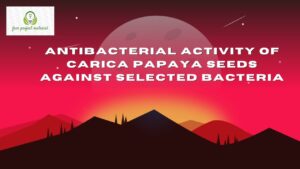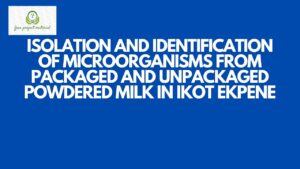ABSTRACT
The aim of this study was the comparative analysis of heavy metal in cowskin Singed with Tyre and Firewood in Abattoirs. The result revealed the following: The cowskin Singed with firewood Pb (0.10±1.245), Cd (1.035±0.002), Cr (1.573±0.002), Cu (4.525 ±2.131), Zn (2.345±0.44). Cowskin roasted with Tyre had the following Pb (2.006±0.009), Cd (0.967±0.003), Cr (1.603 ± 0.001), Cu (3.859±0.008), Zn (2.98±0.011). From this study it is more preferable to singed cowskin with firewood than tyre as it had less heavy metal content.
TABLE OF CONTENTS
Title Page – – – – – – – – – i
Declaration – – – – – – – – – ii
Certification – – – – – – – – – iii
Dedication – – – – – – – – – iv
Acknowledgements – – – – – – – v
Table of Contents – – – – – – – – vii
Abstract – – – – – – – – – x
CHAPTER ONE
1.0 INTRODUCTION
1.1 Background of the study – – – – – – 1
1.2 Aim and Objectives of the study – – – – 6
1.3 Scope and Limitation of the Study – – – – 7
1.4 Definition of Terms – – – – – – 7
CHAPTER TWO
2.0 LITERATURE REVIEW
2.1 Meat – – – – – – – – – 8
2.2 Nutritional Importance of Meat in Human Diet – – 10
2.3 Meat Consumption and Health Issues – – – – 13
2.4 Meat Processing and Consumer Perception – – – 15
2.5 Types of Cow skin meat – – – – – – 18
2.6 Chemical Composition of Cattle Hide – – – – 20
2.7 Wood Smoke – – – – – – – 21
2.8 Composition of Rubber Tyre – – – – – 23
2.9 Exposure Pathways of Heavy Metals And
Their Effects on Human Health – – – – – 24
CHAPTER THREE
3.0 MATERIALS AND METHOD
3.1 Materials – – – – – – – – 27
3.1.1 Preparation of Reagent Used – – – – – 27
3.2 Method – – – – – – – – 28
3.2.1 Study Area – – – – – – – – 28
3.2.2 Sample Collection and Preparation – – – – 28
3.2.3 Analysis Procedure – – – – – – 29
CHAPTER FOUR
4.0 RESULT AND DISCUSSION
4.1 Result – – – – – – – – – 30
4.2 Discussion – – – – – – – – 31
CHAPTER FIVE
5.0 CONCLUSION AND RECOMMENDATIONS
5.1 Conclusion – – – – – – – – 34
5.2 Recommendations – – – – – – – 35
References
CHAPTER ONE
1.0 INTRODUCTION
1.1 Background of the Study
In Nigeria and other parts of Africa, in addition to the regular consumption of red meat, the habit of eating singed goat and cow hide is a common practice (Okiei et al., 2009). This practice poses a threat not only to the health of its consumers, it also threatens the leather industry that use this hide as a raw material. This is the reason why Government and non-Governmental organizations have been enlightening individuals against the consumption of goat and cow hides (Leita et al., 2009). The methods of hide removal in slaughtered animals and the process of singeing hide for human consumption are done mostly according to different cultures (Dada et al., 2017). Ruminant animals like goat and cow, after hide removal, are normally singed to get rid of the fur. Singeing in an open fire is the major process by which fur of the skin of slaughtered goat and cow is removed (Omojola et al., 2010). In African countries, singeing is largely preferred in several ways because it preserves the animal’s hide for consumption and evokes taste in it that are strongly desirable and acceptable by the local population (FAO, 2005).
Processed goat and cattle hides are popularly known as “ponmo” in South-Western Nigeria and “Ganda” in the Northern part of the country and they are served as food delicacy in several homes (Okiei et al., 2009; Obiri-Danso et al., 2008). Singeing is mainly done by the use of firewood as fuel, but the relative scarcity of firewood in recent times has resulted in local butchers using plastics, scrap car tyres and charcoal (Obiri-Danso et al., 2008). Tyre derived fuel‟ (TDF) carry several heavy metals like lead (Pb), zinc (Zn), copper (Cu) that could be carcinogenic if consistently exposed over a long period by consumers. Furthermore, high level of heavy metals were detected in goat and cowhide as a result of singeing with scrap automobile tyre and this make it dangerous for human consumption (Obiri-Danso et al., 2008). Singeing of hides with hazardous substances could contaminate the environment, meat products and can also have adverse health implications (Okiei et al., 2009). Water bodies located near the abattoir often get contaminated with these hazardous substances through runoffs and other improper management of abattoir waste (Adelegan, 2002).
An abattoir is where the butchering of animals and preparing of meat items for human utilization is performed. Activities in abattoir generate large volume of wastes which are discharged improperly to the environment. The wastes generated from abattoir have been reported to have negative impact on the receiving environment (Ebong et al., 2020). A variety of organic fuels sources are being utilized for the roasting/processing of meat, fish and cowhide. These include animal dung (in some countries) to corn cobs, through a variety of soft and hard woods. Within the Niger delta region, organic fuel used for roasting fishes include firewood, bamboo, saw dust, palm fruit chaff, grass straw, coconut husk among others. Also, fuel sources being flared for roasting cowhide in Rivers state include expired automobile tyres, firewood, waste plastics, kerosene to mention a few. Since there is considerable variation in the composition of various fuels, the components of smoke vary widely. The reactions involved in the production of smoke and its components will depend largely upon individual fuels and their composition (Albert and Ravendra, 2020).
Heavy metals are essentially metallic chemical elements that have a relatively high density and are toxic at high concentrations, Examples include arsenic, lead, copper, iron, zinc, nickel. Metals such as copper, iron, zinc, and nickel are essential metals since they play important roles in biological systems, whereas cadmium and lead are non-essential metals and they are harmful even in small concentration (Fernandes et al., 2008). Heavy metals are bio-accumulative and therefore require close monitoring (Bhattacharya et al., 2008).
Low level metal toxicity is recognized by the Environmental Protection Agency (EPA), the Food and Drug Administration, FDA, and the Center for Disease Control (CDC) as well as individual state health departments in London. The American Heart Association states that blood level of lead and cadmium may increase the risk of peripheral artery disease-even at level currently considered safe. Low-level toxicity from heavy metals and resulting “oxidative stress” are associated with a depressed immune system, increased infertility, cancer cardiovascular disease, and premature mortality. Emerging evidence shows that blood and bone lead levels, reflecting relatively modest exposures, are also associated with hypertension, renal insufficiency, and cognitive impairment. Studies conducted at the National Academy of Science (NAS) show clearly the danger of heavy metals in our bodies. Many authors (Albert et al., Hu, et al., 2002; Mclennan et al., 2001 and Uauy et al., 2003) have recently reported on the risks associated with heavy metals, n-3 fatty acids in animal diets and coronary diseases vis-à-vis sudden death in man. Our focus, therefore, is to assess levels of metals in the cow skin roasted with tyres and firewood in abattoirs in Ikot Ekpene L.GA.
1.2 Aim and Objectives of the Study
The aim of this study is comparative analysis of heavy metal in cowskin popularly known as ponmo singed with tyres and firewood in abattoirs in Ikot Ekpene L.G.A.
The objectives of this study are;
- To determine the heavy metal contents of cow skin Singed with tyres
- To determine the heavy metal composition of cow skin Singed with firewood
- To compare the heavy metal composition of the cow skin Singed using tyres and firewood as fuel
1.3 Scope and Limitation of the Study
This study focuses on the comparative analysis of the heavy metal composition of cow skin Singed with tyre and firewood in Abattoirs in Ikot Ekpene L.G.A. due to time and financial constraints.
1.4 Definition of Terms
Abattoirs: This is a place where animals are butchered: slaughterhouse
Heavy metal: This is any metal with a specific gravity of 5.0 or greater, especially one that is toxic to organisms, such as lead, mercury, copper, and cadmium
Polycyclic aromatic hydrocarbon (PAH): PAHs are a class of organic compounds produced by incomplete combustion or high-pressure processes.
Cowhide: Cowhide is the natural, unbleached skin and hair of a cow. It retains the original coloring of the animal.
Singeing: This is the process of lightly or superficially burning something.


